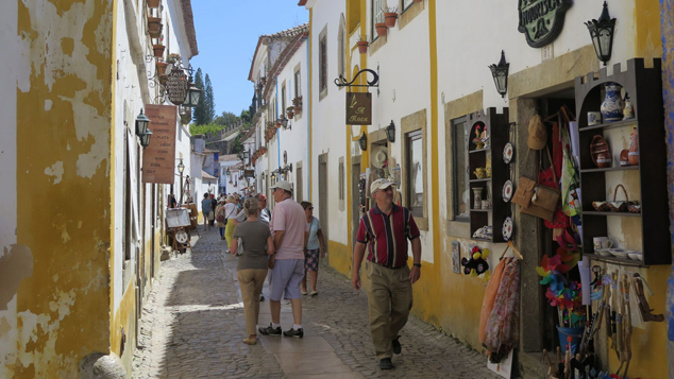
Obidos is the sort of place that instantly casts you under its spell. The medieval hilltop town, in the Centro Region of Western Portugal, worked its magic on me from the moment I alighted from my Trafalgar coach like a frisky puppy. Encircled by a classic crenellated city wall, the Moors began the fortifications in the 8th century, which were later expanded following their overthrow. My trusty Trafalgar guide, Pedro, effusively shared with us the ‘lost in time” town’s back story as we strolled through the main entry gate, Porta de Vila, which navigates you directly into the picture-perfect main drag, Rua Direita. www.trafalgar.com
Stop to admire the magnificent eighteenth-century azulejo tiles decorating the entrance. Yes, the main street bustles like a classic tourist trap, but the flower-bedecked white-washed houses lining the street, edged in mustard and cobalt-blue trim, produce a knock-out first impression. Luxurious blooms of bougainvillea and honeysuckle were all ablaze. It is irresistibly gorgeous. After all, this is the town that the King of Portugal gifted to his Queen as a wedding present in the 13th century. Obidos remained the property of Portugal’s many Queens until 1883.
Amidst the typical tourist tat on the main street, you’ll stumble upon some exquisite local handicraft sellers, enticing galleries and truly quaint al fresco cafes, in between being exhorted to sample the town’s most exalted product, morello cherry liqueur. Officially known as Ginja de Obidos, exuberant street cart vendors beckon you to sample this decadent little treat, which is served in a petite and edible chocolate cup. Drink the liqueur and gobble the cup- double the decadence! Bottles of this cherished liqueur make for a trusty take home souvenir.
A labyrinth of narrow, cobbled lanes fan out from the main street, revealing sublime vistas and hidden pockets of charm, away from the heady tourist buzz. Sightseeing essentials? Drool over the town’s elegant old churches, Santa Maria and St. Peter’s, with their hand-painted tiles, covering every inch of the ceilings and walls. The commanding medieval castle looks like a scene straight out of Hollywood. With its striking edifice, colossal gates and battlements, it’s now a luxurious hotel, Pousada de Obidos. Even if you’re not staying in-house, it’s a spectacle to behold and you’re welcome to walk the castle walls free of charge.
Pedro tipped me off Hollywood did actually come to town, casting Obidos as Lilliput in Gullivers Travels. Head behind the castle to the outer grounds, and you’ll get a flavour of Lilliput, with its reconstructed Middle Ages buildings, which also play host to the annual Medieval Festival. Staged in July, this is when Obidos really steps back in time with its costumed parade, jugglers, wandering minstrels, jousting knights and handicraft fair.
Like Obidos, Portugal’s heartland brims with a surprising trove of understated treasures. Another such specimen that should be included on any self-respecting Portuguese touring itinerary is the Bucaco National Park. ( Also spelt as Bussaco.) Traversing this pocket of magic with Trafalgar, I was awestruck by the enchanting forest, studded with 700 varieties of trees. Many were brought to Europe by Portuguese explorers.
For a 1000 years it served as a monastic retreat for the Carmelites, and speckled throughout the forest are secret grottoes, waterfalls, fountains, and tiny hermitages. The Carmelite monks developed a ravishing botanical garden, a showcase of plant varieties from all over the globe, including New Zealand punga ferns and pohutakawas. A shot of patriotism coursed through me. This garden of Eden enjoyed solid papal protection - anyone who destroyed a tree was threatened with excommunication.
Steeped in history, one of the major battles of the Peninsula War took place here, when the Duke of Wellington defeated Napoleon's troops in 1810. You can still Wellington’s Olive Tree, a 500 year old specimen, inscribed with a plaque denoting that it was where the duke tethered his horse when he stayed here. After all religious orders were dissolved in Portugal in 1834, the royal family fell in love with the convent gardens and Bucaco Palace was constructed in 1888, alongside the old convent. The neo-Manueline architecture is absolutely show-stopping. Revel in the unrestrained architectural fantasy that suffuses the palace, as it now operates as one of Portugal’s luxury country hotels. www.bussacopalace.com
Mike is Newstalk ZB’s Travel Correspdondent on Saturday Mornings with Jack Tame. 11.20am
Take your Radio, Podcasts and Music with you









